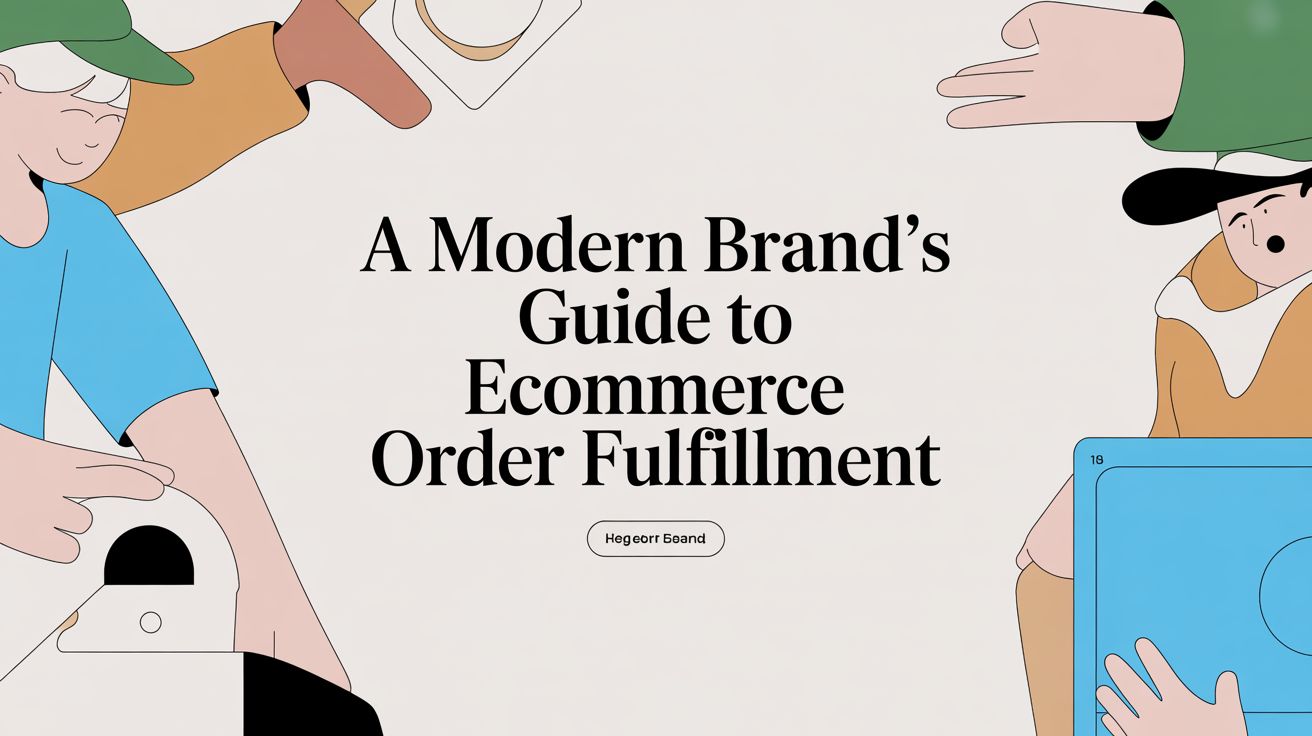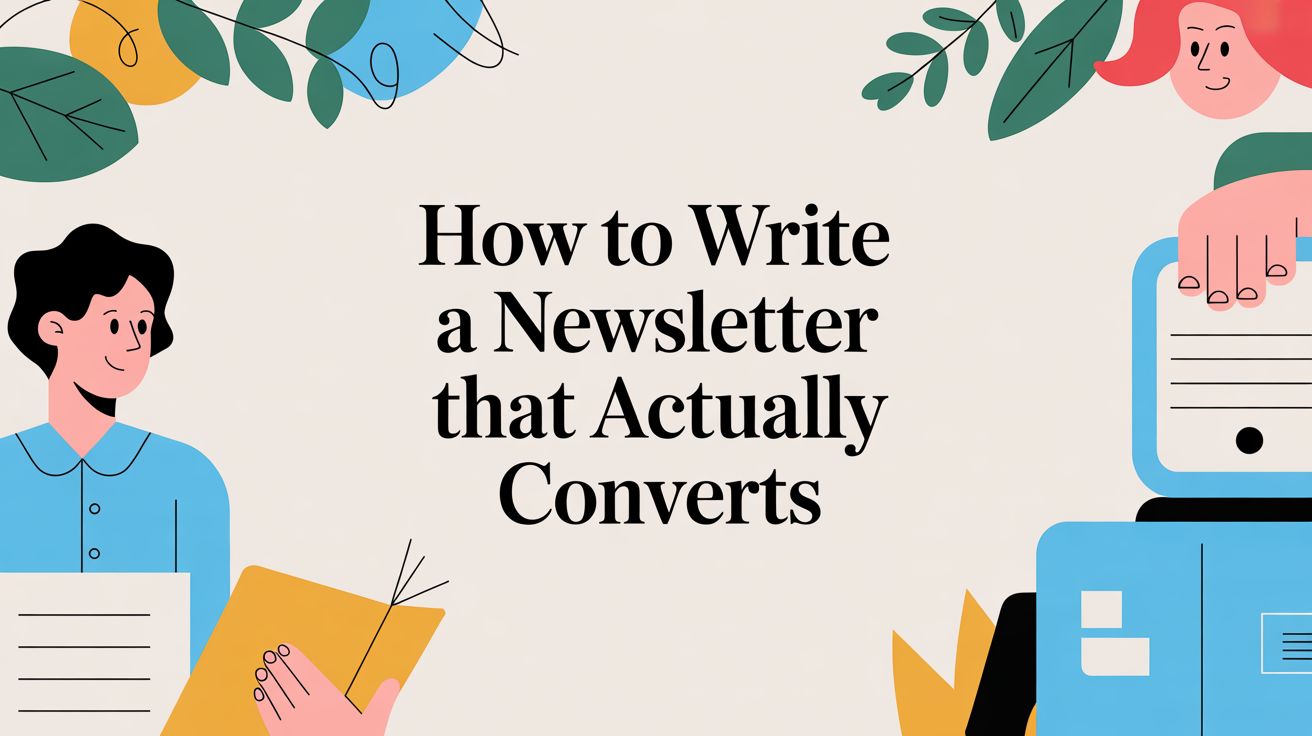
How to Increase Ecommerce Conversion Rates

If you want to boost your ecommerce conversion rates and, more importantly, your revenue, you must look past generic tips. It’s time to adopt a structured, three-pillar framework grounded in consumer psychology: master the digital storefront experience, apply the science of urgency, and optimize the path to purchase.
This isn't about tweaking a few buttons. It's a strategic shift from chasing vanity metrics to building a holistic system that turns the traffic you already have into consistent, profitable revenue.
Why Your Conversion Rate Is Costing You Money
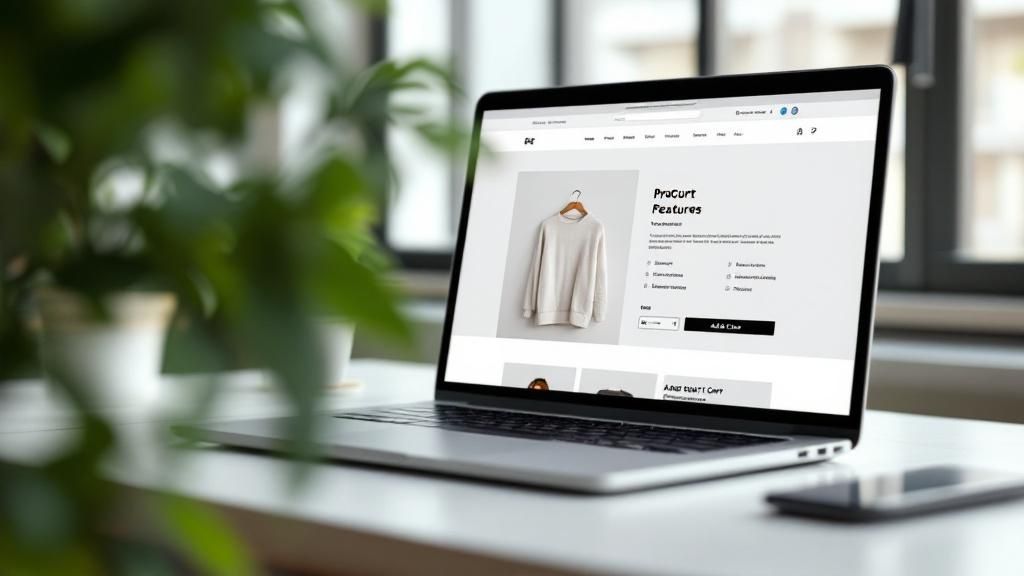
Too many ecommerce brands see their conversion rate as just another number on a marketing dashboard. In reality, a low conversion rate is a massive leak in your revenue pipeline. It actively drives up your customer acquisition costs (CAC) and shrinks your profit margins with every sale you don't make.
Think about it: every dollar you pour into ads to bring visitors to your site is a sunk cost if they don't buy. Understanding this financial impact is the first step toward building a more profitable online business. When you focus on improving conversions, you're making your entire marketing budget work smarter, not just harder, leading to a direct increase in ROI.
The Financial Drain of a "Typical" Rate
Industry benchmarks float the global average ecommerce conversion rate somewhere between 2% and 4%. But that figure can be all over the map depending on your industry. The personal care sector, for example, might see rates as high as 6.8%, mostly because those are often lower-cost, repeat buys that don't require a ton of thought. You can dig into more ecommerce conversion rate benchmarks on networksolutions.com.
But relying on those broad averages is dangerous. If your store is converting at 2%, that means 98 out of every 100 visitors are walking away empty-handed. That’s a direct hit to your bottom line, forcing you to spend more just to acquire each paying customer, which eats away at your profits.
Let's put this in perspective. An incremental lift from 2% to 3% isn't just a 1% gain; it's a whopping 50% increase in revenue from the exact same amount of traffic. That’s the real power of conversion rate optimization.
A Framework for Profitable Growth
To move the needle on revenue, you need a clear, actionable roadmap. Random "tips and tricks" lead to scattered efforts and minimal impact. A structured approach, on the other hand, gives you a comprehensive strategy for turning browsers into buyers and protecting your profit margins.
Before we dive deep, let's get a high-level view of the framework this guide is built on. It all comes down to three core pillars that work together to create a high-converting machine.
| Pillar | Core Principle | Key Tactics |
|---|---|---|
| Mastering the Digital Storefront | Build immediate trust and create an effortless, intuitive shopping experience from the moment a visitor lands on your site. | Site speed optimization, clear navigation, high-quality product photography, compelling copy, mobile-first design. |
| Applying Consumer Psychology | Go beyond basic pop-ups and tap into the science of behavioral economics to motivate action authentically. | Scarcity, social proof (reviews), sophisticated urgency marketing (like with Quikly), loss aversion, anticipation. |
| Optimizing the Path to Purchase | Remove every point of friction from the product page to the final "thank you," reducing cart abandonment. | Streamlined checkout process, clear calls-to-action (CTAs), transparent shipping costs, abandoned cart recovery emails. |
By focusing on these three areas, you can systematically plug the leaks in your conversion funnel. You stop guessing and start building a powerful engine for sustainable, profitable growth.
Build a Digital Storefront That Earns Trust
Think of your website as your best salesperson—the one that never sleeps. But what happens if that salesperson is slow, confusing, or untrustworthy? They won't close any deals. Building a digital storefront that earns instant trust is the absolute foundation of learning how to increase ecommerce conversion rates.
Those first impressions are made in just a few milliseconds and directly influence whether a visitor sticks around or bounces. This goes way beyond a pretty design; it’s about making things easy for your shoppers. When someone lands on your site, they shouldn't have to think. Every single element, from your navigation to your product photos, should intuitively guide them toward that purchase.
Create a Frictionless Mobile Experience
Mobile shopping isn't a trend anymore, it's the default. While mobile devices account for a whopping 73% of global ecommerce traffic, their conversion rates still trail far behind desktops—hovering around 2.9% for mobile versus 4.8% for desktop. That gap usually boils down to one thing: a clunky, frustrating user experience that sends shoppers running for the hills.
Closing that gap means committing to a seamless, mobile-first design. And no, that doesn't just mean your site shrinks to fit a smaller screen. It demands a real focus on speed and simplicity.
- Optimize for Speed: Every second matters. A slow-loading page is the ultimate conversion killer. Compress your images, streamline your code, and make sure your store loads in the blink of an eye.
- Simplify Navigation: Think thumb-friendly. Use a clean menu that's easy to tap. Make sure your search bar is front and center, offering smart suggestions to help people find what they need, fast.
- Streamline Checkout: Integrate one-click payment options like Shop Pay or Google Pay. This completely removes the tedious chore of manually typing in shipping and payment details on a tiny screen. Actionable Takeaway: For Shopify merchants, enable Shop Pay in your settings. It pre-fills customer information, reducing checkout steps by over 60%.
Leverage High-Quality Visuals and Compelling Copy
Online shoppers can't touch or feel your products. That means your photos and descriptions have to do all the heavy lifting to bridge that gap and build their confidence. Vague copy and blurry images create doubt. Professional visuals and benefit-driven copy create desire.
Your product detail page (PDP) is your final pitch. It has to answer every question and squash every hesitation a shopper might have.
The goal of a product page is to replicate the in-store experience as closely as possible. High-resolution images from multiple angles, zoom capabilities, and even product videos give shoppers the confidence they need to click "Add to Cart."
When writing your product descriptions, stop focusing on features and start focusing on the problem your product solves. How does it make the customer’s life better, easier, or more fun? Use scannable bullet points to call out the key benefits and tell a story that connects with your ideal customer. Great copy is essential to helping consumers feel confident in their decision to buy from you.
Build Trust with Social Proof and Transparency
Before pulling out their credit card, today's shoppers look for validation from people just like them. This is social proof, a powerful psychological principle, and it's one of the most effective tools in your conversion toolkit. By weaving authentic customer reviews, star ratings, and user-generated photos directly into your product pages, you give shoppers the unbiased reassurance they crave.
Transparency is just as crucial. One of the biggest culprits behind the shocking 70% average cart abandonment rate is unexpected costs at checkout. Surprise shipping fees and taxes are a major source of friction that completely erodes trust at the finish line.
Be upfront about every single cost. Display shipping info clearly on the product page or provide a shipping calculator right in the cart. A simple, honest pricing structure gets rid of those nasty surprises and paves a smooth, trustworthy path from browsing to buying.
Use Urgency Marketing to Drive Action
Once you've built a trustworthy storefront, it's time to dig into the science of consumer psychology. This is where we move past basic, often annoying pop-ups and into a sophisticated strategy grounded in behavioral economics. This is how you generate immediate revenue and manage inventory without sacrificing profit margins.
Effective urgency marketing isn’t about tricking people with fake timers. It’s about tapping into powerful, hard-wired human drivers like scarcity, the fear of missing out (FOMO), and anticipation.
Generic countdown timers that just reset on refresh do more harm than good, eroding the trust you worked so hard to build. True urgency marketing science uses sophisticated, trigger-based campaigns that create genuine "Moments" of excitement. Think limited-time flash sales with a real deadline or a product drop with actual limited inventory. This approach, superior to basic pop-ups, turns a simple purchase into a memorable brand experience.
Beyond Basic Timers and Pop-Ups
The standard pop-up playbook is almost entirely focused on one thing: capturing an email address. And while building your list is important, that strategy does very little to convert high-intent shoppers who are on your site right now. Its primary goal is lead generation, not revenue generation.
A smarter approach to urgency is engineered for a much more profitable goal: driving immediate revenue.
Instead of just asking for an email, you're giving them a compelling reason to buy today. This has a direct, measurable impact on your ROI. By creating real demand, you can move inventory faster and protect your margins. We see brands, especially on platforms like Shopify Plus, use this to launch flash sales that sell out in minutes—all without resorting to the deep, site-wide discounts that can devalue their products.
Behavioral economics teaches us that the fear of missing out on a potential gain is a more powerful motivator than the promise of the gain itself. A well-executed urgency campaign leverages this principle, known as loss aversion, to prompt decisive action from shoppers who might otherwise hesitate.
This psychological trigger is exactly why a limited-edition product drop generates so much more buzz and sells so much faster than a standard 20% off sale. The opportunity feels exclusive and fleeting, which makes the decision to buy feel more immediate and emotionally satisfying.
The Power of Anticipation and Scarcity
One of the most overlooked tools in urgency marketing is anticipation. Building hype before a sale or product launch creates a captive audience that's ready to purchase the second the offer goes live. You're not just making a passive announcement; you're creating an active event.
Here are a few actionable takeaways you can implement:
- Pre-Launch Campaigns: Start teasing a future flash sale or limited stock release to your email and SMS lists. Using tools like Klaviyo allows you to automate this process and build excitement in the days leading up to the launch.
- Tiered Access: Give your most loyal customers early access. This is a great way to reward them, but it also creates a powerful sense of FOMO that gets the rest of your audience talking.
- Real-Time Stock Counters: When inventory for an item is genuinely low, a simple message like "Only 5 left in stock!" creates credible scarcity. It’s far more believable and effective than a generic timer because it's based on a real-world constraint. For Shopify stores, this can often be enabled with a simple app or theme customization.
This infographic lays out a simple framework for testing which of these urgency tactics connects best with your specific audience.
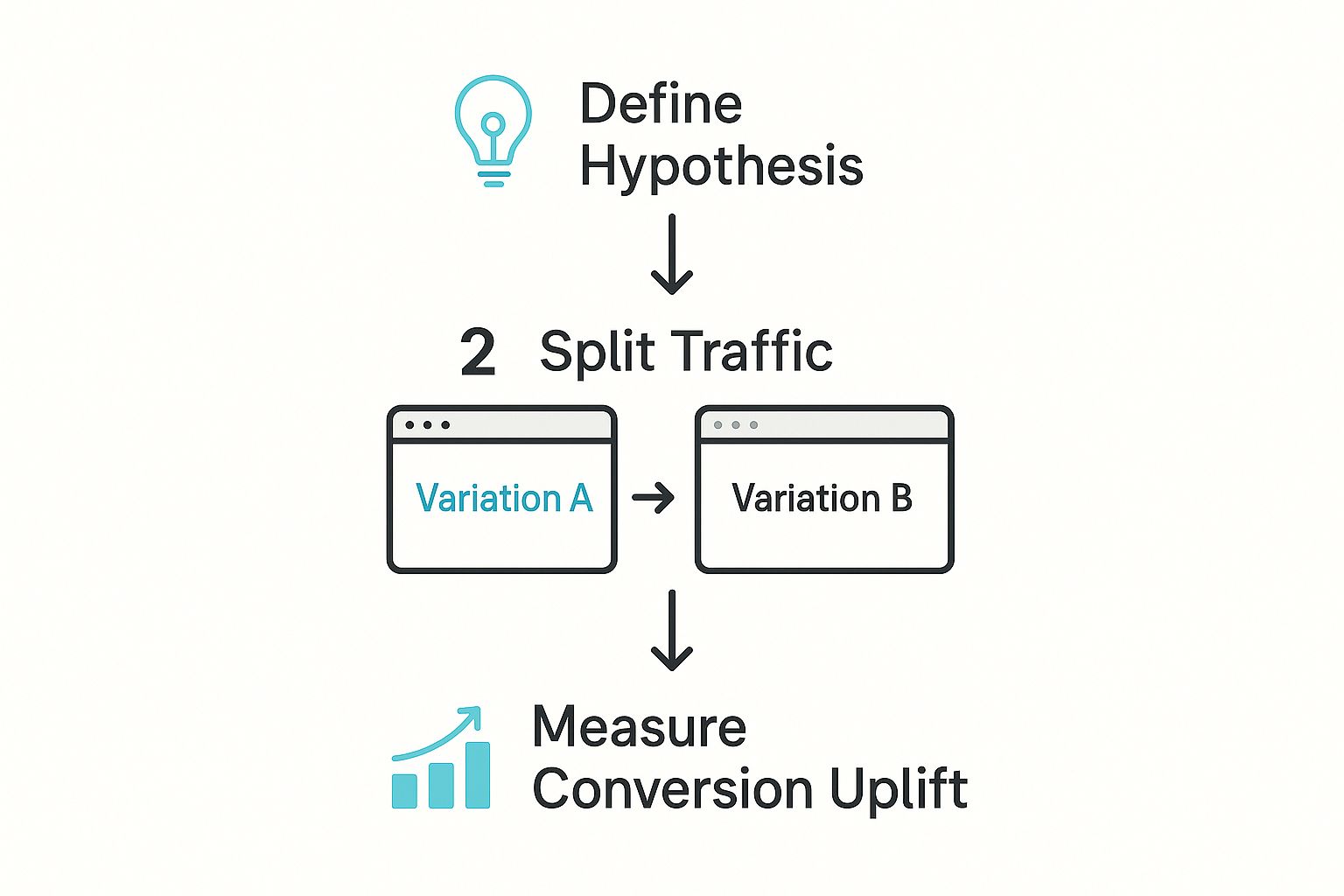
This process helps you shift from guesswork to data-driven decisions, making sure your campaigns are always optimized for maximum impact.
Integrating Urgency into Your Customer Journey
Urgency marketing shouldn’t exist in a vacuum. It’s most powerful when you weave it seamlessly throughout the entire customer journey. When you integrate a sophisticated platform like Quikly with your email service provider, for example, you can create a truly cohesive and high-converting experience.
Picture a shopper who abandons their cart. Instead of just sending a standard "Did you forget something?" email, you could invite them to a limited-time flash sale on the very items they were considering. This automated, trigger-based approach feels personal and timely, creating a powerful nudge to complete the purchase. You can explore more ideas and create urgency for your e-commerce site with these 4 tips.
By shifting your focus from cheap gimmicks to the science of consumer behavior, you can not only boost your conversion rates but also build a more engaging and profitable brand.
Craft a High-Converting Product Page
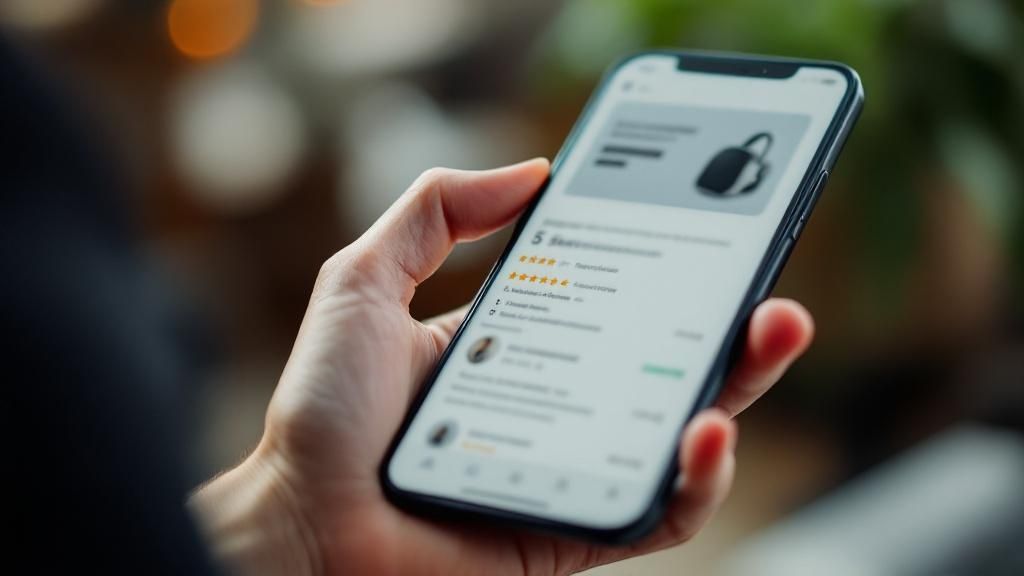
Think of your product detail page (PDP) as the final sales pitch. This is that critical moment where a curious browser decides to either hit "add to cart" or simply bounce. In this make-or-break environment, every single element has to work in harmony to build desire, squash doubts, and eliminate any hesitation.
The competition is absolutely massive. With global eCommerce sales expected to hit $6.86 trillion, fueled by 2.77 billion online shoppers, a generic product page just won't cut it. A thoughtfully crafted PDP is your single most powerful tool for grabbing your piece of that pie. You can see more on the growth of online retail at sellerscommerce.com.
Write Copy That Solves a Problem
Shoppers don't buy products; they buy solutions. They're looking for a better version of themselves. Your product descriptions need to transcend a boring list of features and instead paint a picture of tangible benefits. This is your chance to translate technical specs into real, emotional outcomes.
For instance, don't just say a backpack has "water-resistant nylon." That's a feature. Instead, frame it as a benefit: it "keeps your laptop safe and dry during unexpected downpours." That simple shift taps directly into a core customer anxiety and shows them exactly why that feature matters. Good copy gets inside the customer's head, anticipates their needs, and reassures them that your product is the answer.
This isn't just a marketing trick; it's rooted in a psychological principle called cognitive fluency. When information is easy for our brains to process, we naturally develop a more positive feeling toward it. Benefit-driven copy is just plain easier for a shopper's brain to latch onto than a sterile list of specs.
Build Undeniable Authority with User Content
Today's shoppers are skeptical. They've heard all the brand messaging before. But what they do trust, overwhelmingly, are the opinions of their peers. This is exactly why integrating user-generated content (UGC) is one of the most powerful moves you can make to boost conversions. Authentic reviews, customer photos, and video testimonials provide the social proof people need to feel confident in their purchase.
A study found that displaying UGC can increase conversion rates by as much as 161%. It completely changes the dynamic, turning your product page from a monologue into a lively conversation where real customers are vouching for you.
Here’s how to put this into action effectively:
- Showcase Visual Reviews: Actively encourage customers to send in photos or videos of them using your product. If you sell apparel, this is invaluable for helping new shoppers see the fit and style on different body types.
- Feature Q&A Sections: Let potential buyers ask questions and allow previous customers to jump in with answers. This builds an incredible sense of community and crowdsources a powerful, trustworthy knowledge base.
- Highlight Key Snippets: Don't make people dig for the good stuff. Pull the most compelling lines from reviews and feature them prominently, maybe right next to your "add to cart" button. A single quote like, "This is the best I've ever used," can be the final nudge someone needs.
Demonstrate Value with Video and Dynamic Content
Product photos are table stakes. Video is where you really start to win. A short, well-produced video can show your product in action, explain a complex feature, or highlight its quality in a way static images never could. It helps bridge that sensory gap that comes with online shopping, letting customers see the product from every angle and imagine it in their own lives.
But before you can even think about crafting a page, you need to be sure you’re offering products that truly connect with your audience. A great starting point is to explore the best product research tools to find those winning items customers are already searching for.
For those on Shopify Plus, you can take this even further with dynamic content. Think about using smart product recommendations to display "Frequently Bought Together" bundles or suggesting complementary items based on what a user has been browsing. This doesn't just make the shopping experience feel more personal and relevant; it directly boosts your average order value (AOV) by intelligently upselling and cross-selling.
Optimize Your Checkout to Reduce Abandonment
The path from "Add to Cart" to "Complete Purchase" is the final, most precarious stage of the whole journey. It's also where an incredible amount of potential revenue just vanishes.
The average cart abandonment rate hovers stubbornly around 70%. Think about that. Optimizing your checkout process isn’t just a nice-to-have—it’s a direct investment in your bottom line.
Every bit of friction, every unexpected question, and every moment of hesitation can send a motivated buyer running for the hills. Your job is to make these final steps so seamless and trustworthy that clicking "buy" feels like the most natural thing to do. This is where you lock in revenue.
Streamline the Path to Purchase
The secret to a high-converting checkout is simple: reduce cognitive load. In other words, don't make your customers think so hard. Every single field they have to fill out is a potential exit point. Your checkout needs to feel less like filling out paperwork and more like an express lane.
This is exactly why a guest checkout option is non-negotiable. Forcing someone to create an account before they can give you their money is one of the oldest—and most costly—mistakes in the book. It throws up a massive psychological barrier right when they're ready to commit.
By offering a guest checkout, you align with the shopper's immediate goal: giving you their money. You can always prompt them to create an account on the "thank you" page after the sale is secure. All the friction is gone by then.
A progress indicator is another surprisingly powerful tool. A simple visual bar showing steps like "Shipping," "Payment," and "Confirm" instantly lowers anxiety. It makes the process feel manageable and answers that nagging subconscious question, "How much longer is this going to take?" before it turns into frustration.
Provide Flexible and Trusted Payment Options
In the final moments before a purchase, trust is everything. Shoppers need to feel completely confident that their financial information is safe. One of the best ways to build this last-minute confidence is by offering a variety of familiar, trusted payment methods.
Integrating digital wallets is an absolute must, especially on mobile.
- One-Click Solutions: Options like Shop Pay, Apple Pay, and Google Pay get rid of the annoying task of manually typing in credit card and shipping details.
- Alternative Payments: Services like PayPal or "Buy Now, Pay Later" (BNPL) options from companies like Klarna cater to different preferences, opening the door to more customers.
When you display these logos, you're essentially borrowing their hard-earned credibility. If you're using Shopify or Shopify Plus, enabling these express payment options is as easy as flipping a switch in your settings. It's a simple move that can immediately lift conversion by smoothing out the biggest friction point in the entire flow.
Recover Abandoned Carts with Strategic Urgency
Even with a perfect checkout, some shoppers will still leave. This is where a smart cart recovery strategy becomes your most profitable automation. A single, sad "You forgot something!" email just doesn't cut it anymore.
To claw back those lost sales, you need a multi-channel approach grounded in behavioral psychology. This means setting up automated sequences that reach customers on both email and SMS, using platforms like Klaviyo.
But here’s the key: give them a compelling, time-sensitive reason to come back now.
Instead of just a reminder, what if your follow-up was an invitation to a 24-hour flash sale on the items in their cart? Suddenly, the message isn't about what they abandoned; it's about an opportunity they're about to miss. This plays on loss aversion—the fear of missing out on a great deal—to create a powerful nudge back to the checkout.
For a deeper dive into this, you can explore more on how to prevent cart abandonment according to behavioral science. This approach transforms your recovery emails from passive reminders into an active, revenue-generating machine.
Your Top Conversion Rate Questions, Answered
If you’re wading into the world of conversion optimization, you’ve probably got questions. It’s a field full of nuances, and it’s easy to get turned around. Let's tackle some of the most common hurdles ecommerce merchants run into.
What Is a Good Ecommerce Conversion Rate?
A good ecommerce conversion rate is the rate at which visitors to an online store complete a desired action, typically a purchase. While industry averages hover around 2-4%, a "good" rate is highly contextual, depending on the industry, product price point, and traffic source. The most important benchmark is a consistent improvement over your own historical data.
Think about it this way: a brand selling affordable cosmetics might easily hit a 6% conversion rate or even higher. These are frequent, low-thought purchases. But a high-end furniture store? A 1.5% conversion rate could be fantastic for them, given the much longer and more considered buying journey.
The only benchmark that truly matters is your own past performance. Aim for steady, data-driven improvements month after month.
How Can I Reduce Cart Abandonment on Shopify?
First things first, you need to go through your own checkout and find the friction. The usual suspects? Mandatory account creation and surprise shipping costs. You can knock out a huge chunk of friction right away by enabling guest checkout and turning on one-click options like Shop Pay.
Being transparent is also huge. Nobody likes a last-minute fee tacked on. Make sure every cost is crystal clear before the customer has to pull out their credit card.
Next, you absolutely need a cart recovery automation. Using a tool like Klaviyo that syncs up with Shopify, you can set up a smart sequence of emails and texts to bring shoppers back. The best recovery campaigns don't just say, "Hey, you forgot something." They create a real, time-sensitive reason to finish the purchase, tapping into powerful behavioral psychology.
A fake timer that endlessly resets just makes you look shady and kills customer trust. But when urgency is tied to a real constraint—like a flash sale ending or a genuinely low stock level—it works. It taps into authentic principles like scarcity and FOMO to create genuine opportunities, not manufactured pressure.
Are Urgency Tactics Like Countdown Timers Manipulative?
They certainly can be. When urgency isn't rooted in reality, it feels deceptive. A generic countdown timer that just starts over every time you refresh the page screams "gimmick" and instantly damages your brand's credibility. A lot of basic pop-up apps fall into this trap because they focus on tricks instead of genuine psychology.
But when it's done right, urgency marketing is simply the application of behavioral science. It creates exciting moments for your customers by highlighting actual scarcity, like a limited-edition product drop, or by building buzz for a flash sale that has a real end date. The goal is to create valuable, can't-miss opportunities for your audience, which actually builds loyalty instead of tearing it down. This is sophisticated psychology, not manipulation.
What Metrics Matter Besides Conversion Rate?
Your conversion rate is a vital sign, but it's not the whole story. If you only focus on that one number, you're missing the bigger picture of your store's health. To really understand your growth potential, you need to keep a close eye on these metrics too:
- Average Order Value (AOV): How much do people typically spend when they buy from you?
- Customer Lifetime Value (CLV): Over time, how much is one customer really worth to your business?
- Customer Acquisition Cost (CAC): How much does it cost you to bring in a new customer?
A truly solid conversion optimization strategy doesn't just bump up one number—it has a positive ripple effect across all of these metrics, paving the way for more profitable and sustainable growth.
Ready to stop using basic timers and start using the real science of urgency marketing to drive revenue? See how Quikly uses behavioral economics to create high-converting campaigns your customers will actually get excited about.
Learn more at https://hello.quikly.com.

The Quikly Content Team brings together urgency marketing experts, consumer psychologists, and data analysts who've helped power promotional campaigns since 2012. Drawing from our platform's 70M+ consumer interactions and thousands of successful campaigns, we share evidence-based insights that help brands create promotions that convert.
